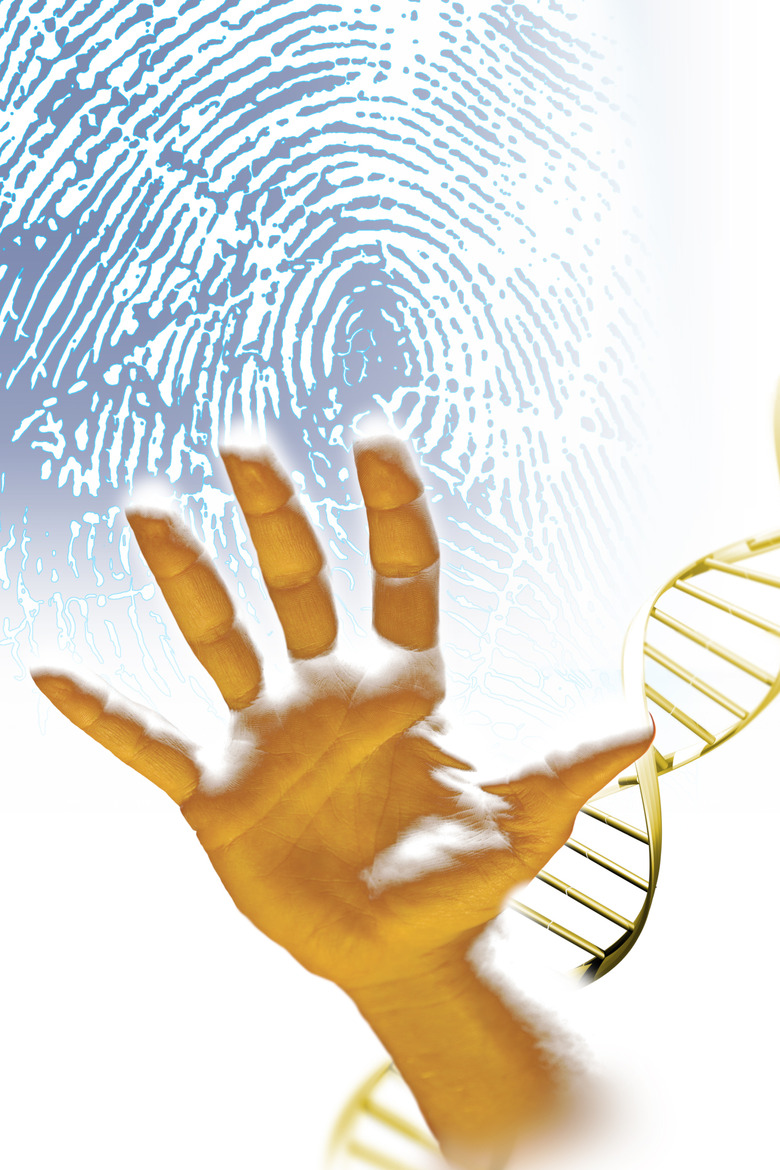The Difference Between Gene Sequencing And DNA Fingerprints
Just like the traditional fingerprinting techniques made famous by detective fiction, DNA fingerprinting of individuals takes place by sampling their DNA and comparing it with a sample found at a crime scene. DNA sequencing, by contrast, determines the sequence of a stretch of DNA. Although DNA sequencing and DNA fingerprinting involve some of the same techniques, the ultimate aim of each is different and they have different applications.
DNA
DNA
Your DNA is a chain of chemical units called base pairs, each of which is typically represented by a letter: either A, G, C or T. The sequence of those "letters" determines the function of a piece of DNA, just as the sequence of ones and zeroes in binary computer code determines what tasks the computer will perform. In DNA sequencing, scientists take a piece of DNA and determine the sequence of letters it contains in an effort to use it or find out more about its function. Your complete DNA sequence is called your genome. Each individual's genome is unique, just like a fingerprint.
Fingerprinting
Fingerprinting
Unlike sequencing, fingerprinting does not attempt to determine sequence. The goal of fingerprinting is to determine whether a sample of DNA-containing material like blood came from a given individual. Certain regions of the genome are pretty similar from one individual to another but certain other regions are highly variable. The most important variable regions for DNA fingerprinting are called microsatellites. These microsatellites contain a short sequence that is repeated many times. The number of repeats varies greatly from one individual to another. By comparing the number of repeats in certain specific microsatellite regions, forensics experts can determine with high probability whether the DNA from two different samples is a match.
Goals
Goals
DNA fingerprinting is faster and cheaper than DNA sequencing but provides less information. You can use DNA sequencing to find out whether a sample came from a given individual, or even to identify the father of a child, but DNA fingerprinting will not give you any information about an individual's actual DNA sequence — the sequence of "letters" that makes up his genetic code. DNA fingerprinting is generally used in forensics to match samples with suspects, while DNA sequencing is generally used in scientific research, where scientists need to know the sequence of a piece of DNA to figure out more about its function.
Techniques
Techniques
Some of the techniques used in DNA fingerprinting and DNA sequencing are similar but there are some differences. DNA fingerprinting makes use of a technique that makes many copies of a short stretch of DNA and gel electrophoresis, a technique that separates pieces of DNA based on their size. DNA sequencing, by contrast, uses more complicated techniques to specifically to determine the sequence of letters in a piece of DNA. The difference can be compared to using an inked thumbprint to identify someone, as opposed to analyzing all the details about how the thumb works.
References
- Human Genome Project Information: DNA Forensics
- Genetics: A Conceptual Approach, Second Edition, pages 543-545: Benjamin A. Pierce
Cite This Article
MLA
Brennan, John. "The Difference Between Gene Sequencing And DNA Fingerprints" sciencing.com, https://www.sciencing.com/difference-between-gene-sequencing-dna-fingerprints-5010/. 24 April 2017.
APA
Brennan, John. (2017, April 24). The Difference Between Gene Sequencing And DNA Fingerprints. sciencing.com. Retrieved from https://www.sciencing.com/difference-between-gene-sequencing-dna-fingerprints-5010/
Chicago
Brennan, John. The Difference Between Gene Sequencing And DNA Fingerprints last modified March 24, 2022. https://www.sciencing.com/difference-between-gene-sequencing-dna-fingerprints-5010/
